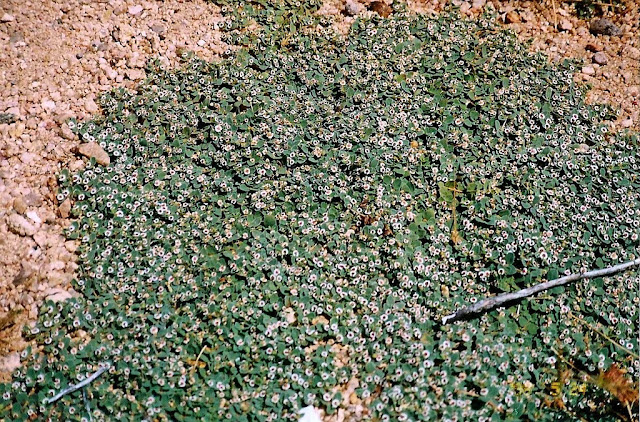The Desert Tortoise (Gopherus agazzizi) is the official State Reptile of California. And, I must say, its affable nature, inimitability, laid back ways, and general good looks (pretty cute for a reptile) makes it quite deserving of such a noble title. I've only seen a desert tortoise in the flesh once before, and that was at Red Rock Canyon State Park in Kern County, just a few miles north of the Desert Tortoise Natural Area. In fact, it was on our way back from a camping trip at Red Rock in the spring of 1998, that we decided to detour towards California City and check out the DTNA.
Desert tortoises take quite a few years to reach maturity and can live up to 100 years. Unfortunately, predation and loss of habitat have rendered these unique critters endangered. The DTNA encompasses 25,000 acres of public lands and in 1980 was designated as an Area of Critical Environmental Concern due to the high population densities of the desert tortoise in this area (up to 100-200 per square mile in some parts of the DTNA).
The best time to come out here is in the spring, when you might catch a glimpse of a tortoise or tortoises outside their burrows. We didn't actually see any of these guys on our visit here, but that may have been due to the fact that we arrived around noontime when it was really warming up. Regardless, the DTNA is worth a stop: there's an interpretive kiosk, a couple self-guided nature trails, and a naturalist present during the spring months.
Desert tortoises take quite a few years to reach maturity and can live up to 100 years. Unfortunately, predation and loss of habitat have rendered these unique critters endangered. The DTNA encompasses 25,000 acres of public lands and in 1980 was designated as an Area of Critical Environmental Concern due to the high population densities of the desert tortoise in this area (up to 100-200 per square mile in some parts of the DTNA).
The best time to come out here is in the spring, when you might catch a glimpse of a tortoise or tortoises outside their burrows. We didn't actually see any of these guys on our visit here, but that may have been due to the fact that we arrived around noontime when it was really warming up. Regardless, the DTNA is worth a stop: there's an interpretive kiosk, a couple self-guided nature trails, and a naturalist present during the spring months.
3/24/98 Gil pointing at a tortoise shell (not a live one). I promise, despite his cheeky grin, he didn't kill it...
Animal Loop Trail, Desert Tortoise Natural Area.
3/24/98 Rattlesnake Weed (Euphorbia albomarginata). Plant Loop Trail, Desert Tortoise Natural Area.
Animal Loop Trail, Desert Tortoise Natural Area.
3/24/98 Rattlesnake Weed (Euphorbia albomarginata). Plant Loop Trail, Desert Tortoise Natural Area.
STATS:
Location: NW Mojave Desert, western edge of the Rand Mountains. A 2- hour drive from Los Angeles, 1 1/2 hours east of Bakersfield.
County/State: NE Kern County, CA
Management: Bureau of Land Management, Ridgecrest Field Office
Size: 25,000 acres (about 40 square miles)
Closest Town: California City
Directions: From either Hwy. 14 or Hwy. 58, exit to California City (California City Blvd.). Drive through California City and turn north onto Randsburg Mojave Rd. Drive 5 1/2 miles to the entrance.
Road Conditions: Randsburg Mojave Road is unpaved but passable to most 2WD vehicles.
Trails: There are a couple self-guided nature trails (trail guides available): Plant Loop Trail is 500 yards; Animal Loop Trail is 1/2 mile with 25 numbered interpretive posts.
Website: http://www.blm.gov/ca/st/en/fo/ridgecrest/deserttortoisenaturalarea.html (BLM)
Fees: None
Amenities: None. Make sure to bring some drinking water, hat & sunscreen.
Contact Info: BLM Ridgecrest Field Office, 300 S. Richmond Rd., Ridgecrest, CA 93555. Tel (760)384-5400. Open 7:30am-4pm M-F.
Fees: None
Amenities: None. Make sure to bring some drinking water, hat & sunscreen.
Contact Info: BLM Ridgecrest Field Office, 300 S. Richmond Rd., Ridgecrest, CA 93555. Tel (760)384-5400. Open 7:30am-4pm M-F.


No comments:
Post a Comment